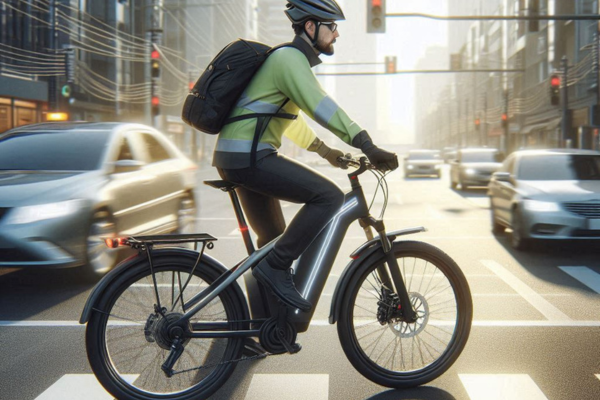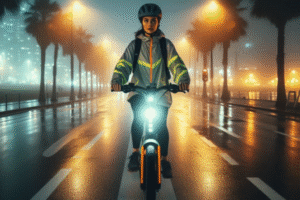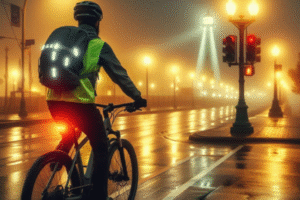🌁 Understanding the Coastal Urban Commute
Why Coastal Environments Pose Unique Risks
🚴♀️ Commuting on an electric bicycle through a coastal city isn’t just transportation—it’s a lifestyle. These e-bike safety tips for coastal urban commuting are designed for riders who face the ocean breeze, unpredictable fog, and packed intersections daily…
🌁 Picture this: It’s 6:45 a.m. in Cartagena. The sun is rising, the humidity clings to your jacket, and mist from the shore reduces visibility to barely two car lengths…
Coastal cities breathe differently. Morning rides are often shrouded in haze, while afternoons bring harsh glares and sudden gusts of wind…
✨ Your gear is important, but your awareness is critical. Don’t assume that just because you have a helmet and a blinking rear light, you’re protected…
🛑 Infrastructure adds to the risk. Many coastal cities include charming but tricky design elements like cobblestone lanes…
💡 One of the smartest things you can do is prepare a pre-ride mental checklist…
- ✅ Are my lights fully charged?
- ✅ Am I wearing reflective gear from multiple angles?
- ✅ Do I know today’s wind conditions and visibility alerts?
- ✅ Are my tires and brakes ready for slick surfaces?
🌍 These routines may feel like extra effort, but they turn chaos into confidence…
🔄 Over the next blocks, we’ll break down key practices that elevate your daily commute…
“🚦 Safety isn’t a feature—it’s a daily decision.” 💡🌊
⚙️ Optimizing Your E-Bike for Coastal Conditions
Brake and Tire Adjustments for Humidity
Lighting Setup for Fog and Twilight
⚙️ Your safety on a coastal e-bike commute doesn’t begin on the road—it starts with the gear you choose and how you prepare your ride…
🛑 Let’s start with brakes. In humid coastal zones, brake pads and rotors deteriorate faster…
🌀 Wind is a silent risk on the coast. Gusts push riders into traffic or cause overcompensation…
🚲 Tire pressure is another silent player. On hot, humid days, pressure fluctuates…
🔋 Next, lighting. You need visibility not just ahead and behind, but all around…
🧤 Gloves, mirrors, and accessories also deserve attention…
🎒 Here’s a checklist of adjustments every coastal e-bike commuter should apply weekly:
- ✅ Brake inspection (pads, rotors, responsiveness)
- ✅ Tire pressure check + debris removal
- ✅ Chain lubrication with anti-corrosion product
- ✅ Charging all lights + backup power
- ✅ Mirror cleaning + alignment
- ✅ Helmet strap + reflector check
According to the National Highway Traffic Safety Administration, mechanical readiness is a top factor in reducing cycling incidents…
“🛠️ Preparation turns unpredictability into peace of mind.” 🔧💨
🔄 Building Daily Safety Habits
Timing Your Ride to Avoid Risk
Real-Life Example: Leila’s Commute Routine
💡 Technical readiness is only half the equation. The other half? Your mindset and daily behavior. Even the most advanced gear can’t replace the power of awareness, anticipation, and consistency. These e-bike safety tips for coastal urban commuting become truly effective when they are paired with smart daily rituals and a clear head.
⏰ Start with timing. Coastal cities operate on rhythms—early fog, midday glare, and late afternoon winds. Shifting your commute by just 15 minutes can change your experience entirely. Try leaving earlier to avoid peak traffic, or observe when bike lanes are less cluttered with delivery scooters and distracted pedestrians. A simple time tweak can dramatically lower your risk of collisions or stress.
👀 Practice “active scanning.” This technique teaches your eyes to continually sweep the path ahead—10 to 20 meters forward—while also checking peripheral zones. You’re not just looking for vehicles. You’re checking for dogs on long leashes, puddles blending with shadows, motorbikes cutting corners, or kids suddenly stepping into the lane. Riders who scan effectively rarely get surprised.
📖 Take Leila, a 32-year-old civil engineer in Lima. Her e-bike commute runs along the Costa Verde and through the historic center. Every evening, she checks the weather forecast and wind index. If fog is predicted, she packs an extra front light and switches from sunglasses to a clear visor. Her reflective jacket is always folded in the back pocket of her backpack, ready to deploy. She doesn’t wait for problems—she plans ahead.
🏁 These are some of Leila’s daily rituals, and they’re worth adopting:
- ✅ Weather check (wind, humidity, fog alerts)
- ✅ Route awareness: construction zones, detours, heavy traffic hours
- ✅ Headlight + rear light test before leaving
- ✅ Brief mirror alignment and hand signal warm-up
- ✅ Reflective layer check—even on short trips
🔄 Repetition builds instinct. Riders who take 3 minutes for a pre-ride checklist reduce mechanical failures and boost their confidence, which is crucial when navigating coastal unpredictability. The point isn’t to ride in fear—it’s to ride in readiness.
📢 Also read: The Visibility Gear Checklist Every Coastal E-Bike Rider Needs
🎯 Your mental presence is your most powerful tool. Don’t ride distracted. Silence non-essential notifications, keep one ear open to your surroundings, and always assume that others don’t see you. Ride predictably, signal clearly, and maintain a position in the lane that gives you space to maneuver around surprises.
🧠 When you combine strategic timing, pre-ride routines, and proactive riding, your safety becomes a habit—not a reaction. These e-bike safety tips for coastal urban commuting only work when they’re practiced with intention. Day after day, you build a routine that protects not just you—but everyone who shares the road with you.
“🌇 Routine doesn’t make you robotic—it makes you resilient.” 🚦✨
🛠️ Gear Configuration and Visibility Checklist
Essential Visibility Gear for Urban Riders
Weekly Maintenance and Equipment Setup
🧰 Equipment isn’t just an accessory for coastal e-bike riders—it’s your first line of defense. In fast-moving cities by the sea, where visibility shifts by the hour and surfaces go from dry to slick in minutes, your gear must evolve from “nice-to-have” to non-negotiable. These e-bike safety tips for coastal urban commuting help you configure your setup not only to be seen, but to react and recover quickly when conditions turn.
💡 Let’s start with lighting. Visibility is multi-directional. You’re not just seen from the front and back—side visibility can mean everything in intersections or roundabouts. Install wheel spoke lights, handlebar-end LEDs, and helmet-mounted strobes. A good setup includes:
- ✅ 400+ lumen front light with flash mode
- ✅ 60+ lumen blinking rear light
- ✅ Side reflectors (frame, tires, and pedals)
- ✅ Rechargeable helmet light
🌧️ Your clothing matters, too. Moisture-wicking fabrics that stay bright even when damp help differentiate you from the environment. Neon yellow, orange, coral, and aqua work great. Avoid dark shades that blend into asphalt or shadows. Choose reflective jackets with built-in venting and layering options. Always carry a lightweight rain poncho that fits over your backpack without covering your lights.
🎒 Backpack visibility is often overlooked. Use a reflective rain cover or attach a clip-on light to your rear pouch. Better yet, wear a high-contrast vest on top of your bag. Motion visibility (such as reflective ankle bands and wrist cuffs) enhances driver awareness by creating movement patterns our brains recognize faster.
🔔 Signaling equipment should match your environment. In high-noise zones, use a horn instead of a bell. Choose a model with adjustable volume. Mirror placement is essential—install wide-angle mirrors on both handlebars or use a helmet-mounted version for enhanced rear view awareness without head turning. For added safety, some commuters use smart helmets with integrated brake lights and turn signals synced to handlebar buttons.
🔧 Maintenance gear should be part of your daily carry. Keep a waterproof pouch with these essentials:
- ✅ Mini-pump with gauge
- ✅ Tire levers and patch kit
- ✅ Multi-tool with hex keys and chain breaker
- ✅ USB power bank for lights or phone
- ✅ Dry lube and cloth for chain after wet rides
🧠 Routine inspections are just as important as the ride. Schedule one day a week for a full safety check. Look at brake pad wear, tire pressure, battery life, chain tension, and light brightness. Don’t just glance—test. The five minutes you invest could prevent an injury or mechanical failure during peak traffic.
📦 Here’s a weekly visibility checklist for coastal riders:
- ✅ Helmet check + straps tight
- ✅ All lights charged and operational
- ✅ Visibility gear refreshed (replace faded tapes or worn vests)
- ✅ Weather-appropriate layering packed
- ✅ Toolkit stocked and stored in waterproof case
🔄 Integrating this gear into your daily routine ensures that e-bike safety tips for coastal urban commuting don’t stay in theory—they become second nature. A well-prepared rider isn’t just safer—they’re more confident, more visible, and more respected on the road.
“✨ The best riders don’t just wear gear—they become part of it.” 🚴♀️🛡️
💬 Final Thoughts and Community Insights
Riding with Awareness and Purpose
FAQs – Common Questions from Coastal Riders
💛 After all the technical upgrades, daily routines, and visibility strategies, the final piece of the puzzle is mindset. These e-bike safety tips for coastal urban commuting only work when paired with intention, compassion, and awareness—not just for yourself, but for everyone who shares your path.
Being an e-bike commuter in coastal cities means navigating narrow roads, shifting weather, and distracted drivers. It also means being part of a growing movement—one where clean mobility, health, and environmental stewardship intersect. Every light you install, every hand signal you make, every mirror you check—it all says: “I value my life, and I’m helping others value theirs too.” 🌍✨
You are more than a rider. You’re an example. Children watching from sidewalks learn how to ride safely from you. Drivers remember your lights when they check their blind spots. Other cyclists follow your lead when you stop at crosswalks or slow down in dense zones. Don’t underestimate the power of presence. 🚦
🌊 Coastal cities are alive—fluid and unpredictable. Some days will be windy and wild. Others, smooth and radiant. Your goal isn’t to control them. It’s to flow with them while staying fully seen and fully aware. That is the art of e-bike commuting by the sea.
“💡 The most powerful safety gear is your decision to be seen.” 🌟🚴♀️
📣 Join the Coastal E-Bike Community
What tips have helped you stay safe in your city? Do you have a fog strategy that others should know about? A favorite gear hack? Share it in the comments or tag us with a photo of your commuter setup. Let’s build a network of smart, seen, and unstoppable e-bike riders along every coastline. 🌐📸
❓ Frequently Asked Questions (FAQs)
Q: What’s the best light configuration for foggy mornings?
A: Use a high-lumen (400+) front light with strobe, a bright rear blinker, and add side spoke lights or frame-mounted LED strips for lateral visibility. Helmet lights also help when looking sideways at intersections.
Q: How often should I check my brakes in a humid climate?
A: Weekly. Look for squeaking, delayed stop time, or rust buildup. Clean rotors with alcohol wipes and replace pads as needed. If you ride daily, check pads visually every three days.
Q: Can reflective tape make a big difference?
A: Absolutely. Reflective tape on moving parts (like legs or wheels) creates motion cues that drivers spot more quickly, especially in low visibility or twilight conditions.
Q: Are mirrors really necessary?
A: Yes. Coastal roads are unpredictable, and shoulder-checking repeatedly can destabilize you in wind. Mirrors let you track approaching traffic while keeping your posture intact.
Q: What if my city doesn’t have proper bike infrastructure?
A: Stick to roads with wide shoulders, use daylight hours when traffic is lighter, and invest in high-contrast gear. Share reports with your city’s planning department—they often rely on citizen data to improve.
Your e-bike journey is not just about getting from A to B—it’s a statement. With every ride, you show what safety, sustainability, and smart design look like in action.
Thank you for being part of this movement. You’re not just riding—you’re reshaping the future of mobility in our coastal cities. 🌴💛



